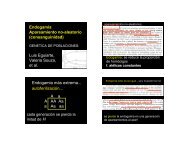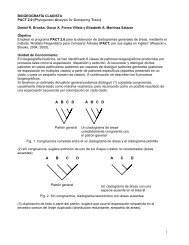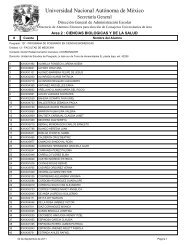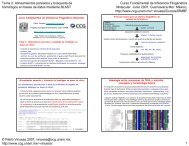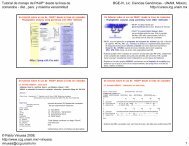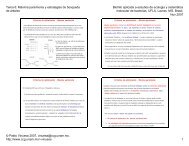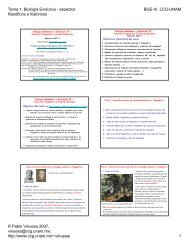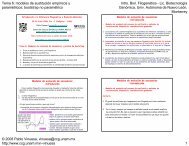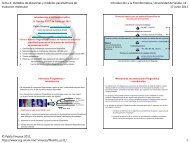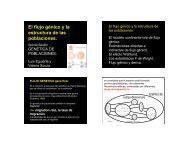Chromosome Structure
Chromosome Structure
Chromosome Structure
You also want an ePaper? Increase the reach of your titles
YUMPU automatically turns print PDFs into web optimized ePapers that Google loves.
<strong>Chromosome</strong> <strong>Structure</strong>TelomereTopoIV Escherichia coli Gyrase+ SupercoilsWatsonCrick+ CatenanesArs1TopoIIEukaryotesTopoIFigure 4 Topology of DNA replication. Movement of a replication forkproduces positive supercoiling ahead of the fork and results inentanglements of the sister chromosomes, called catenanes, behind thefork. Positive supercoils are removed by gyrase in bacteria and by TopoI ineukaryotes, whereas TopoIV resolves catenanes in bacteria and TopoII ineukaryotes.Centromerereplicated by a special DNA polymerase called telomerase,which is related to the reverse transcriptase ofretroviruses.Telomerase synthesizes a simple repeat sequence that isadded on to every chromosome using an RNA templatethat is part ofthe enzyme. In most organisms telomerase isnot expressed after cell differentiation, and consequentlythe telomere sequences shorten with age, eventuallycausing cell senescence and death.TerminationArs2TelomereFigure 3 <strong>Structure</strong> and replication pattern of a eukaryotic chromosome.Eukaryotic chromosomes are linear structures which have special structuresat each end called telomeres (green) and an organizer centre called thecentromere which attaches the chromosome to the spindle duringchromosome segregation. Replication is initiated at ars sites, andreplication is carried out semidiscontinuously so that the two strands arereplication isomers.One segment ofa eukaryotic chromosome that isdifferent from prokaryotic chromosomes is the tip of thechromosome, the telomere (Figure 3). Telomeres areIn E. coli, replication is completed in a region ofthechromosome called the terminus, which is 1808 around thecircular genetic map from oriC. Two special sites are foundnear the terminus. First, the terminus is surrounded by atleast six ter sites (Figure 2, blue boxes) which bind the Tusprotein. A ter–Tus complex induces replication forks tostop or pause in a unidirectional fashion by impeding themovement ofDnaB helicase. Ter sites work in only oneorientation, and they are ordered so that replication forkscan proceed to the terminus but not continue in thedirection opposite to normal fork movement. Thus, tersites ensure that replication produces no more than oneround ofsynthesis per initiation event. The second specialsite at the terminus is called dif, which functions tomonomerize dimeric chromosomes during segregation (seebelow in site-specific recombination). The processesinvolved in terminating eukaryotic replication forks arenot yet known.SegregationAt the conclusion ofreplication ofa circular chromosome,all physical barriers must be eliminated before daughterchromosomes completely separate. Replication leavessister chromosomes interlocked by multiple catenane links(Figure 1). To uncuff the DNA molecules, both gyrase andDNA topoisomerase work together. Once chromosomes6 ENCYCLOPEDIA OF LIFE SCIENCES / & 2001 Macmillan Publishers Ltd, Nature Publishing Group / www.els.net



